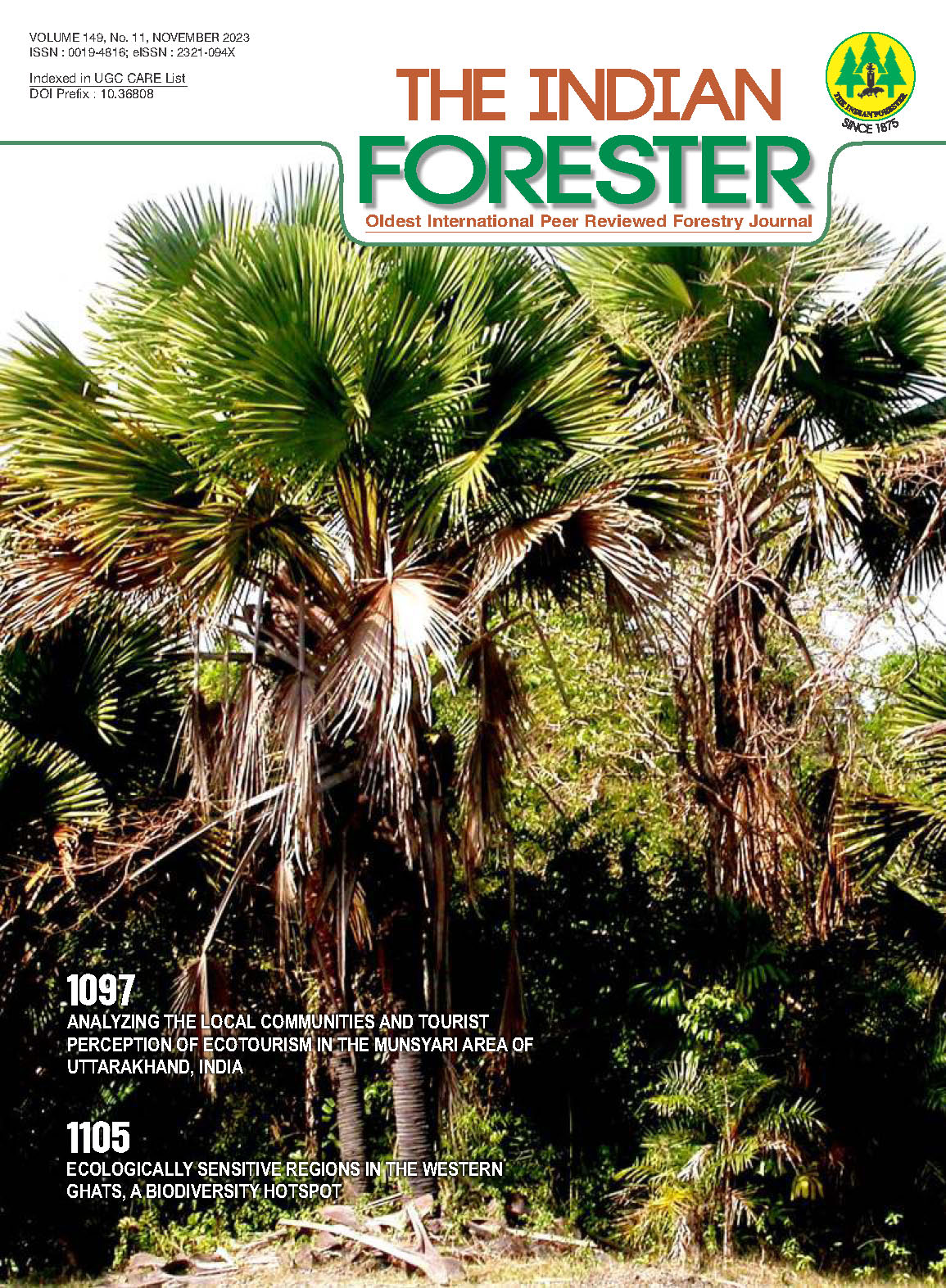Population and Production of Seed of Buchanania lanzan Spreng in Dhenkanal Forest Division of Odisha, India
DOI:
https://doi.org/10.36808/if/2023/v149i11/169896Keywords:
Buchanania lanzan, Dhenkanal Forest Division, Population, Production, NTFP.Abstract
Buchanania lanzan is a deciduous tree belonging to the family Anacardiaceae. Tasty ripen fruit (berry) is nutritive, and the kernel (after decortications of the hard shell of the seed/ stone) is known as Chironji for trade. Chironji not only gives attractive prices to primary collectors but also generates employment for the rural workforce during the lean period. In the present study, the method of Stratified Ranked Set Sampling and Adaptive Cluster Sampling has been used in Dhenkanal Forest Division, Odisha, India. There are about 43,96,000 poles and trees in the division with a seed yield of 821.4g/tree/year and 72% eligible fruit bearer leading to 1,200t seed/year. The highest number of seedlings and saplings along with maximum yield was found in the Hindol range, however, the mean Chironji yield per tree in terms of fresh berry weight (7.02kg±1.10) and dry seed weight (1.67±0.26) are found highest in Sadangi which significantly differs with other forest ranges. This shows that yield per tree is not the same across all areas under study. Tree girth is positively and negatively correlated to the seed yield and hundred seed weight respectively. If the biotic/abiotic factors operate within the threshold limit, productivity can be assured sustainably.References
Champion G.H. and Seth S.K. (1968). A revised survey of the forest types of India. New Delhi: Manager of Publications.
Chandra G., Bhoj D.S. and Pandey R. (2018a). Simple unbalanced ranked set sampling for mean estimation of response variable of developmental programs. Journal of Modern Applied Statistical Methods, 17(1): Article 28. DOI: 10.22237/jmasm/1543856083.
Chandra G., Pandey R., Bhoj D.S., Nautiyal R., Ashraf J. and Verma M.R. (2018b). Ranked set sampling approach for response estimation of developmental programs with linear impacts under successive phases. Pakistan Journal of Statistics, 34(2): 163-176.
Chandra G., Tiwari N. and Chandra H. (2011). Adaptive cluster sampling based on ranked sets.MetodoloskiZvezki,8(1):39-55.
Chandra G., Tiwari N. and Nautiyal R. (2019). Two stage adaptive cluster sampling based on ordered statistics. Metodoloski Zvezki, 16(1): 43-60.
Chauhan P.S., Singh J. and Kavita A. (2012). Chironji: Promising tree fruits of dry subtrop- ics. Horticulture Flora Research Spectrum, 1(3): 375-379.
Evans M.J. (1967). Application of ranked set sampling to regeneration surveys in areas direct-seeded to longleaf pine. Masters Thesis, School of Forestry and Wildlife Management, Louisiana State University, Baton Rouge.
Halls L.K. and Dell T.R. (1966). Trials of ranked set sampling for forage yields. Forest Science, 12: 22-26.
Kumar A., Chandra G. and Kumar S. (2019). Estimating bark eating caterpillars Indarbe- laquadrinotata (walker) in Populous deltoides using ranked set sampling. Indonesian Journal of Applied Statistics, 3(1): 1-11.
Latpate R., Kshirsagar J., Gupta V.K. and Chandra G. (2021). Advanced sampling methods. Singapore: Springer.
Martin W.L., Sharik T.L., Oderwald R.G. and Smith D.W. (1980). Evaluation of ranked set sampling for estimating shrub phytomass in Appalachian Oak Forests. Blacksburg, Vir- ginia: School of Forestry and Wildlife Resources, Virginia Polytechnic Institute and State University, FWS, 4-80.
McIntyre G.A. (1952). A method for unbiased selective sampling using ranked sets. Australian Journal of Agricultural Research, 3: 385-390.
Samawi H.M. (1996). Stratified ranked set sample. Pakistan Journal of Statistics, 12(1): 9-16.
Singh U., Wadhawani A.M. and Johri B.M. (1996). Dictionary of economic plants in India. New Delhi: Indian Council of Agricultural Research, pp. 34-35.
Thompson S.K. (1990). Adaptive cluster sampling. Journal of the American Statistical Association, 85: 1050-1059.
Tiwari N., Chandra G. and Nautiyal R. (2019). Ranked set sampling: A review with new initiative on extreme ranked set sampling. Statistics and Applications, 17(1): 121-139.
Downloads
Downloads
Published
How to Cite
Issue
Section
License
Unless otherwise stated, copyright or similar rights in all materials presented on the site, including graphical images, are owned by Indian Forester.





